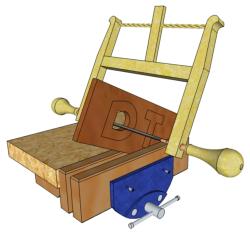Bowsaw: Difference between revisions
From DT Online
m (Added single quotes) |
mNo edit summary |
||
| (6 intermediate revisions by the same user not shown) | |||
| Line 1: | Line 1: | ||
[[File: | [[File:Bowsaw.jpg|300px|right]] | ||
__TOC__ | |||
Traditional Bowsaws consist of a wooden frame and were used for cutting curved shapes in thicker materials than for a '''[[Coping saw]]''' and '''[[Fretsaw]]''' but their use in D&T workshops has been much replaced by a '''[[Bandsaw]]''' or '''[[Jigsaw]]'''. | |||
=====Description===== | |||
[http://en.wikipedia.org/wiki/Bow_saw '''Bowsaws'''] are a type of '''[[framesaw]]'''. | |||
Traditional '''Bowsaws''' consist of a wooden frame and were used for cutting curved shapes in thicker materials than for a '''[[Coping Saw|Coping saw]]''' and '''[[Fretsaw]]''' but their use in D&T workshops has been much replaced by a '''[[Bandsaw]]''' or '''[[Jigsaw]]'''. | |||
=====Features and Applications===== | |||
Typically, blades are about 250 to 300mm long and from 10 to 24 teeth per inch ''[[Teeth per Inch|(TPI)]]''. The blade is kept in tension by twisting a loop of cord by means of a length of wood passing through it to create a [http://en.wikipedia.org/wiki/Tourniquet#History ''‘tourniquet’''] or [http://en.wikipedia.org/wiki/Turnbuckle ''‘turnbuckle’''] type action. | Typically, blades are about 250 to 300mm long and from 10 to 24 teeth per inch ''[[Teeth per Inch|(TPI)]]''. The blade is kept in tension by twisting a loop of cord by means of a length of wood passing through it to create a [http://en.wikipedia.org/wiki/Tourniquet#History ''‘tourniquet’''] or [http://en.wikipedia.org/wiki/Turnbuckle ''‘turnbuckle’''] type action. | ||
They are normally used as shown with both hands gripping one of the handles - two handles are provided to allow the blade to be turned and cut in different directions. | They are normally used as shown with both hands gripping one of the handles - two handles are provided to allow the blade to be turned and cut in different directions. | ||
[[File:LogSaw.jpg|300px|right|link=http://www.amazon.co.uk/gp/product/B000XJ3RAI/ref=as_li_tl?ie=UTF8&camp=1634&creative=6738&creativeASIN=B000XJ3RAI&linkCode=as2&tag=dton06-21]] | |||
Modern '''Bowsaws''' have a metal tube frame with very coarse blades about 600mm long. They are used mainly for rough cutting of logs and shrubbery with few applications within a D&T workshop. | |||
<div style="clear: both;"></div> | |||
{{Frame Saw Buyers Guide}} | |||
[[Category:Secondary]] | |||
[[Category:Cutting Tools]] | |||
Latest revision as of 09:23, 25 November 2019
Description
Bowsaws are a type of framesaw.
Traditional Bowsaws consist of a wooden frame and were used for cutting curved shapes in thicker materials than for a Coping saw and Fretsaw but their use in D&T workshops has been much replaced by a Bandsaw or Jigsaw.
Features and Applications
Typically, blades are about 250 to 300mm long and from 10 to 24 teeth per inch (TPI). The blade is kept in tension by twisting a loop of cord by means of a length of wood passing through it to create a ‘tourniquet’ or ‘turnbuckle’ type action.
They are normally used as shown with both hands gripping one of the handles - two handles are provided to allow the blade to be turned and cut in different directions.
Modern Bowsaws have a metal tube frame with very coarse blades about 600mm long. They are used mainly for rough cutting of logs and shrubbery with few applications within a D&T workshop.












